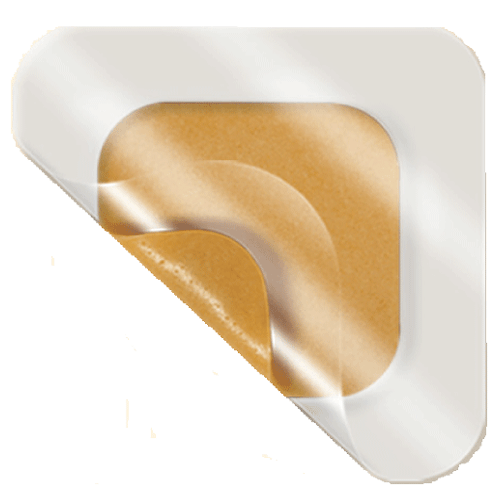Medihoney Hydrogel Sheet Dressing with Adhesive Border 10/box
Medihoney Hydrogel Sheet with Adhesive Border is a wound dressing that contains an added leptospermum honey based to treat moderate draining wounds and stage 2 and 3 pressure ulcers. Medihoney wound dressing features an adherent boarder with a honeycolloid center pad. The honey pad provides antibacterial protection against infection and optimizes the pH level of the wound as it cleanses and debrides the wound for an ideal wound healing environment. Each adhesive dressing is available in two sizes, is non-toxic, natural and safe.
- 31720 Medihoney dressing 2.8" x 2.8" (4.3" x 4.3" with adhesive border) 10 dressing per box
- 31740 Medihoney dressing 4.5" x 4.5" (6" x 6" with adhesive border) 10 dressing per box
Medihoney comes in a variety of forms – one of which is an adhesive dressing! This easy-to-use honeycolloid dressing utilizes medical-grade honey as its main active ingredient. This particular species of honey, Leptospermum, has been proven to provide many great benefits in the area of wound and burn care. Not only does it keep an antiseptic wound environment to prevent infection, but it also draws moisture from beneath to keep the wound lubricated and at an ideal pH level as it heals. This type of honey is free of pesticides, non-toxic and safe for use on many different kinds of wounds.
Honeycolloid Dressing Applications
- To cover partial to full thickness wounds with light to moderate drainage
- Ideal for Stage II/III Pressure Ulcers and skin tears that can be managed with an adhesive dressing
The Honeycolloid pad actually forms a gel as it warms up with body temperature and comes into contact with wound fluid for optimal wound protection and healing!
Therapeutic effects of honey-based dressings
- Anti-inflammatory
- Bactericidal and bacteriostatic properties
- Debridement properties
- Odor control properties
- Retains bactericidal activity in vitro even after dilution
Medihoney Benefits
- Ingredients are non-toxic, natural and safe
- Comes from a traceable source
- Is free of pesticides and antibiotics
- Sterilized by gamma irradiation destroying any bacterial spores, without loss of product effectiveness
What is Leptospermum Honey?
- The most studied type of honey for the management of wounds and burns
- Derived from the pollen and nectar of specific Leptospermum species of plant in New Zealand and Australia
- Unique in that it maintains its effectiveness even in the presence of wound fluid
- The only species of honey that has been shown in randomized controlled studies to help wounds – that have stalled under first-line treatment – to progress towards healing
How does medical-grade honey work?
- The osmotic pull of Medihoney draws lymph from deeper tissues through wound keeping it moist
- Hydrogen peroxide is produced by the enzyme glucose oxidase in honey, which contributes to its antibacterial activity
- Outflow of lymph fluid helps remove devitalized tissue from the wound bed
- The pH level (near 3.5) improves the wound healing environment
**It has been shown that reducing the pH of a wound will help to modulate harmful proteases and improve oxygen diffusion
Medihoney Adhesive Dressing Features
- Made with 80% active Leptospermum honey
- Pad forms a gel as it warms up with body temp and comes into contact with wound fluid
- Cleanses and debrides
- Helps lower overall wound pH level
- Creates a moisture-balanced environment
- Conducive to optimal healing
- Non-toxic, natural, safe
- The potential for extended wear time (depending on level of wound exudate)
- Easy to use
- 2" x 2" or 4.5" x 4.5" size
- 10 per box
- Sold by the box
**Price varys depending on size chosen
Examples of Microorganisms against which Honey is effective
- Methicillin-resistant Staphylococcus aureus
- Staphylococcus aureus (various)
- Vancomycin-resistant enterococci
- Vancomycin-sensitive enterococci (various isolates)
- Pseudomonas aeruginosa
- Beta-hemolytic streptococci (various isolates)
- Alcaligenes faecalis
- Citrobacter freundii
- Escherichia coli
- Enterobacter aerogenes
- Klebsiella pneumonia
- Mycobacterium phlei
- Salmonella California
- Salmonella enteritidis
- Salmonella typhimurium
- Serratia marcescens
- Shigella sonnei
- Staphylococcus epidermidis
- Staphylococcus capitis
- Staphylococcus haemolyticus
- Staphylococcus simulans
- Staphylococcus warneri
Medihoney is great for…
- Skin grafts
- Infected trauma wounds
- Necrotizing fasciitis (Fournier’s gangrene)
- Abscesses
- Pilonidal sinuses
- Ulcers - Pressure ulcers, leg and foot ulcers, rheumatoid ulcers, tropical ulcers (Naga sores), and malignant ulcers
- Lacerations to the leg
- Traumatic wounds
- Burns and scalds
- Meningococcal septicemia skin lesions
- Surgical wounds/infection
- Herpetic lesions
- Atopic dermatitis
- Animal bite wound

